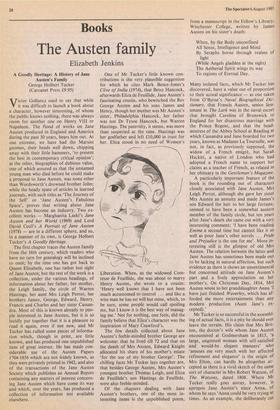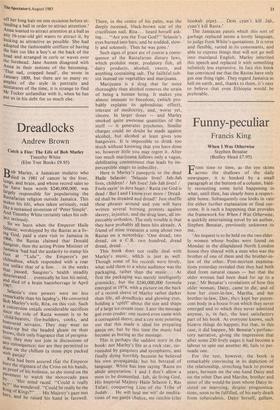Books
The Austen family
Elizabeth Jenkins
A Goodly Heritage: A History of Jane Austen's Family George Holbert Tucker (Carcanet Press £9.95)
fictor Gollancz used to say that while
V it was difficult to launch a book about a character, however interesting, of whom the public knows nothing, there was always room for another one on Henry VIII or Napoleon. The flood of works on Jane Austen produced in England and America during the past 30 years, bears him out. At one extreme, we have had the Marxist gnomes, their heads well down, chipping away with their little hammers, 'to present the best in contemporary critical opinion'; at the other, biographies of dubious value, one of which assured us that the unnamed young man who died before he could make a proposal to Jane Austen, was none other than Wordsworth's drowned brother John; while the heady spate of articles in learned journals, with such titles as 'The Journey of the Self' or 'Jane Austen's Fabulous Space', proves that writing about Jane Austen has become an industry. Two ex- cellent works — Marghanita Laski's Jane Austen and her World (1969) and Lord David Cecil's A Portrait of Jane Austen (1978) — are in a different sphere, and so, in a manner of its own, is George Holbert Tucker's A Goodly Heritage.
The first chapter traces the Austen family from the 16th century, which readers who have no turn for genealogy will be inclined to omit; by the time one has got back to Queen Elizabeth, one has rather lost sight of Jane Austen; but the rest of the work is a collection, under the various headings, of information about her father, her mother, the Leigh family, the circle of Warren Hastings, her aunt Mrs Leigh Perrot, her brothers James, George, Edward, Henry, Francis and Charles and her sister Cassan- dra. Most of this is known already to peo- ple interested in Jane Austen, but it is so lucidly put together that it is a pleasure to read it again, even if not new, and Mr Tucker has culled some pieces of informa- tion which, though in print, are little known, and has produced one unpublished item of great interest. He has made con- siderable use of the Austen Papers 1704-1856 which are not Widely known, as they were privately printed in 1942, and also of the transactions of the Jane Austen Society which publishes an Annual Report containing any matters of interest concern- ing Jane Austen which have come its way and which, over the years, has produced a collection of information not available elsewhere.
One of Mr Tucker's little known con- tributions is the very plausible suggestion for which he cites Mark Bence-Jones's Clive of India (1974), that Betsy Hancock, afterwards Eliza de Feuillide, Jane Austen's fascinating cousin, who bewitched the Rev George Austen and his sons James and Henry, though her mother was Mr Austen's sister, Philadelphia Hancock, her father was not Dr Tysoe Hancock, but Warren Hastings. The paternity, it seems, was more than suspected at the time. Hastings was her godfather and left £10,000 in trust for her. Eliza stood in no need of Women's Liberation. When, as the widowed Com- tesse de Feuillide, she was about to marry Henry Austen, she wrote to a cousin: 'Henry well knows that I have not been much accustomed to control ... and like a wise man he has no will but mine, which, to be sure, some people would call spoiling me, but I know it is the best way of manag- ing me.' Not for nothing, one feels, did the family believe that Eliza's character was the inspiration of Mary Crawford's.
The few details collected about Jane Austen's feeble-minded brother George are welcome: that he lived till 72 and that on the death of Mrs Austen, Edward Knight allocated his share of his mother's estate 'for the use of my brother George'. The chilling facts Mr Tucker lays together are, that besides George Austen, Mrs Austen's youngest brother Thomas Leigh, and Eliza de Feuillide's son Hastings de Feuillide, were also feeble-minded.
Of the chapters dealing with Jane Austen's brothers, one of the most in- teresting items is the unpublished poem, from a manuscript in the Fellow's Library, Winchester College, written by James Austen on his sister's death: When, by the Body unconfined All Sense, Intelligence and Mind By Seraphs borne through realms of light (While Angels gladden at the sight) The Aetherial Spirit wings its way To regions of Eternal Day.
Many isolated facts, which Mr Tucker has discovered, have a value out of proportion to their actual significance — as one taken
from O'Byrne's Naval Biographical Dic- tionary, that Francis Austen, senior lieu- tenant in The Lark was in the naval escort that brought Caroline of Brunswick to England for her disastrous marriage with
the Prince Regent, and that the head- mistress of the Abbey School at Reading at
which Cassandra and Jane boarded for two years, known as Madame La Tournelle, was not, in fact, as previously supposed, the widow of a French emigre, but Sarah Hackitt, a native of London who had adopted a French name to support her claims as a teacher of French, as related in her obituary in the Gentleman's Magazine.
A particularly important feature of the book is the rounding out of characters closely associated with Jane Austen. Mrs Leigh Perrot, although she gave her sister Mrs Austen an annuity and made James's son Edward the heir to her large furtune, seemed to have been a somewhat austere member of the family circle, but ten years after Jane's death she came out with a very
interesting comment: have been reading Emma a second time but cannot like it so well as poor Jane's other novels Pride and Prejudice is the one for me'. More in- teresting still is the glimpse of old Mrs Austen. The relation between the latter and Jane Austen has sometimes been made out to be lacking in natural affection, but such evidence as there is shows an unsentimental but concerned attitude on Jane Austen's part and a lively appreciation on her mother's. On Christmas Day, 1814, Mrs Austen wrote to her granddaughter Anna `I have just finished Waverley, which has af- forded me more entertainment than any modern production (Aunt Jane's ex- cepted).'
Mr Tucker is so successful in the assembl- ing of actual facts, it is a pity he should ever leave the terrain. His claim that Mrs Brit- ton, the doctor's wife whom Jane Austen encountered at Godmersham in 1813, 'a large, ungenteel woman with self-satisfied and would-be elegant manners' who 'amuses me very much with her affected refinement and elegance' is the origin of Mrs Elton, can hardly be altogether ac- cepted as there is a vivid sketch of the same sort of character in Mrs Robert Watson, of The Watson, dated 1808. Where Mr Tucker really goes astray, however, is apropos Jane Austen's niece Anna, of whom he says 'Anna could be very trying at times. As an example, she deliberately cut off her long hair on one occasion before at- tending a ball in order to attract attention.' Anna wanted to attract attention at a ball as any 16-year-old girl wants to attract it, by looking as attractive as possible. She had adopted the fashionable coiffure of having the hair cut like a boy's at the back of the head and arranged in curls or waves over the forehead. Jane Austen disagreed with Anna in their notions of the becoming. That sad, cropped head', she wrote in January 1809, but there are so many ex- amples of the style in portraits and miniatures of the time, it is strange to find Mr Tucker unfamiliar with it, when he has Put us in his debt for so much else.







































 Previous page
Previous page